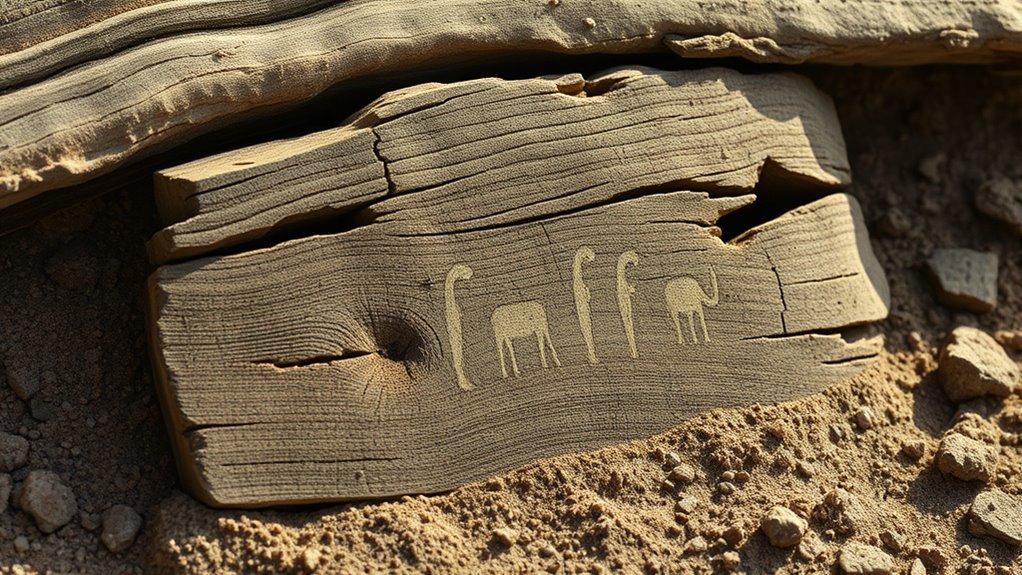Scientists have uncovered a remarkably preserved wooden structure dating back around 476,000 years, revealing that early humans had advanced woodworking skills and engaged in complex construction. This discovery challenges old ideas about prehistoric technology, showing that early humans used tools like stone blades for shaping wood and planned elaborate structures. It suggests their society was more sophisticated than previously thought. Keep exploring to discover how this find rewrites our understanding of human history and development.
Key Takeaways
- The discovery reveals a well-preserved wooden structure dating back approximately 476,000 years.
- It demonstrates advanced woodworking skills and tool use by early humans much earlier than previously believed.
- The structure suggests early humans engaged in building, environmental modification, or symbolic activities beyond basic survival.
- Findings indicate cognitive and cultural development occurred earlier, challenging existing timelines of human technological progress.
- This discovery redefines human ingenuity, showing ancient societies possessed construction abilities comparable to modern techniques.

A recent discovery has revealed a remarkably well-preserved wooden structure dating back approximately 476,000 years, offering new insights into ancient human activity. As you explore this extraordinary find, it becomes clear that early humans possessed a surprising level of skill in ancient craftsmanship. The structure’s careful construction suggests that our ancestors weren’t simply primitive tool users but also capable of complex planning and execution. This discovery challenges previous notions that early humans lacked the dexterity or cognitive ability to create such detailed wooden frameworks, pushing back the timeline of advanced prehistoric skills.
The wooden structure provides direct evidence that ancient humans engaged in activities beyond basic survival. You can imagine them gathering materials, selecting the right wood, and shaping it with prehistoric tools—stone blades, scrapers, and perhaps even early wooden implements. These tools, though simple by today’s standards, were sophisticated for their time, allowing early humans to carve, modify, and assemble materials with precision. The craftsmanship involved in creating the structure indicates that they understood properties of wood, such as its strength and flexibility, and could manipulate it to serve specific functions. This points to a level of technological innovation previously thought to have emerged much later. Additionally, the knowledge of woodworking techniques may have been passed down within communities, enabling the development of increasingly complex projects.
Ancient humans used sophisticated tools to carve, modify, and assemble wood, revealing early technological innovation and craftsmanship.
As you consider the significance of this find, think about how it rewrites what we understand about early human ingenuity. It’s not just about surviving; it’s about building and shaping environments. The wooden structure might have served as a shelter, a communal space, or even a symbolic site—its purpose still debated but undeniably indicative of complex social behavior. The discovery also underscores that prehistoric tools weren’t just used for hunting or cutting but played a crucial role in the creation of durable, lasting structures. This pushes the boundaries of how early humans interacted with their environment and used available resources to their advantage.
You should also appreciate the broader implications of this find for understanding human evolution. It suggests that cognitive and cultural development may have occurred earlier than previously believed. The craftsmanship involved hints at knowledge transfer and skill development within communities, fostering innovations that laid the groundwork for future advancements. Moreover, the use of modern construction techniques by early humans demonstrates a level of ingenuity that reshapes our understanding of prehistoric capabilities. In essence, this wooden structure isn’t just an archaeological curiosity; it’s a tribute to human resilience, creativity, and the enduring drive to shape the world around us. It rewrites the story of our ancestors, revealing that even hundreds of thousands of years ago, humans were capable of remarkable feats of ancient craftsmanship, fueled by ingenuity and resourcefulness.
Frequently Asked Questions
What Tools Did Ancient Humans Use to Build With Wood?
You might wonder what tools ancient humans used to build with wood. They employed simple tools like stone axes, chisels, and scrapers, which left distinct ancient tool marks on the wood. These woodworking techniques required skill and patience, allowing them to shape and assemble structures. By studying these marks, researchers learn about their methods and tools, revealing how early humans crafted wood into shelters, tools, and possibly even artworks.
How Did the Wood Survive for so Many Thousands of Years?
You might wonder how ancient wood survives for thousands of years. Preservation factors like waterlogged environments, which limit decay, and low oxygen levels help protect the wood. In ancient woodworking, natural conditions slow decomposition, preserving timber remarkably well. These factors create ideal conditions, allowing us to find and study ancient wooden structures today. Your understanding highlights the importance of environment in ancient preservation and how it aids archaeological discoveries.
Were There Other Similar Structures Found Nearby?
Think of the archaeological site as a treasure chest, holding secrets of the past. You might wonder if nearby findings mirror this discovery’s significance. While no other structures have been found close by, ongoing excavations continue to explore the area. These efforts could reveal similar ancient remnants, helping us piece together early human life. Stay curious—each excavation brings us closer to understanding our deep history.
What Species of Tree Was Used for the Wood?
You might wonder about the tree species used for the ancient wood. Through wood identification techniques, scientists determined it was likely from a species of oak, known for its durability and widespread presence in the region. This discovery helps you understand the materials early humans or hominins used, revealing insights into their environment and resourcefulness. Knowing the specific tree species enhances your appreciation of ancient craftsmanship and ecological context.
How Does This Discovery Impact Our Understanding of Early Human Migration?
This discovery opens a new chapter in the story of human migration, like opening a long-forgotten door. It shows early humans built enduring prehistoric settlements, suggesting they moved and adapted more widely than we thought. By revealing such ancient structures, you realize migration patterns were complex and far-reaching, challenging previous ideas. This find rewrites your understanding of how early humans spread across the globe, highlighting their ingenuity and resilience.
Conclusion
This discovery challenges everything you thought you knew about human history, proving our ancestors had skills and tools we never imagined. Imagine what other secrets lie buried beneath our feet, waiting to reshape our understanding of the past. Could this be just the beginning of uncovering even older artifacts that redefine your place in history? As we piece together these ancient stories, one thing’s clear: the story of humanity is far more complex and fascinating than we ever imagined.









